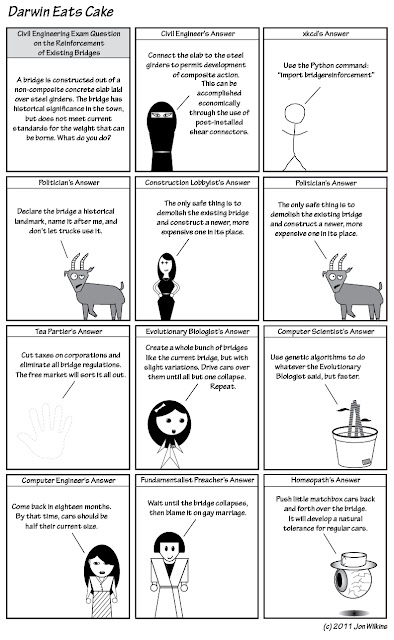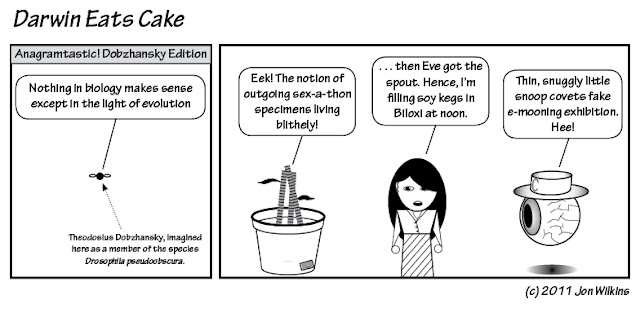So, this is out of order, but please feel free to print these out and hang them up at your next conference.
 |
| Best URL for sharing: http://www.darwineatscake.com/?id=26 URL for hotlinking or embedding: http://www.darwineatscake.com/img/comic/26.jpg |
So, speaking as the author, I would say, yes you should! You should repost it on your blog, share it on Facebook, tweet it, digg it, redditize it, and print it out in hard copy for your grandmother. The only requirement is that you have eyes, or a friend with eyes who can describe the comic to you.
But, I recognize that you might want a little more of a sense of who the target audience is. I hope this helps.
 |
| Best URL for sharing: http://www.darwineatscake.com/?id=28 URL for hotlinking or embedding: http://www.darwineatscake.com/img/comic/28.jpg |
So, this one is not so much science based. Except maybe that biologists eat goat cheese? And pizza. Biologists eat pizza. So, let’s see, every place in this comic where it says “goat cheese” substitute “pizza,” and then it’s biology themed.
 |
| Best URL for sharing http://www.darwineatscake.com/?id=24 URL for hotlinking or embedding: http://www.darwineatscake.com/img/comic/24.jpg |
So, what would you do if faced with an old-style concrete bridge that does not really have the strength that it should?
One solution has been proposed in a PhD dissertation by Gun Up Kwon of the University of Texas. Of course, this post is only marginally about that, but there you go.
These full-size episodes tend to come out poorly on the blog, so if you want to be able to read it more easily, I recommend heading over to Darwin Eats Cake.
Enjoy.
 |
| Best URL for sharing: http://www.darwineatscake.com/?id=23 URL for hotlinking or embedding: http://www.darwineatscake.com/img/comic/23.jpg |
Gun Up Kwon (2008). Strengthening existing steel bridge girders by the use of post-installed shear connectors PhD Dissertation, University of Texas at Austin Other: http://gradworks.umi.com/33/41/3341639.html
So, there’s really no excuse for this, but here it is anyway:
 |
| Best URL for sharing: http://www.darwineatscake.com/?id=22 URL for hotlinking or embedding: http://www.darwineatscake.com/img/comic/22.jpg |
So, I have no privileged knowledge or insight here, but, as I have said before, if I only wrote about things I understood well, this would be a pretty empty blog.
For a more viewable image, or to share, go to http://www.darwineatscake.com/?id=21
 |
| URL for hotlinking or embedding: http://www.darwineatscake.com/img/comic/21.jpg |
So, most biologists are familiar with the quotation by Theodosius Dobzhansky, “Nothing in biology makes sense except in the light of evolution.” In fact, in my experience, if you go to a biology conference, there’s about a 50% chance that at least one of the speakers will introduce their talk with this line. What is typically not made explicit in these talks is, as opposed to what other light?
 |
| Best URL for sharing: http://www.darwineatscake.com/?id=19 URL for hotlinking or embedding: http://www.darwineatscake.com/img/comic/19.jpg |
I have most often heard this quotation used when the speaker is talking to an audience of ecologists or molecular / cell biologists. While both of those fields are clearly tied into evolutionary ideas, explicit thought about evolution is often secondary to other considerations, such as accurately describing the behavior of these very complicated systems on much shorter timescales (months or years in ecology, perhaps down to milliseconds in molecular biology). My sense has always been that people pull out this quotation when they get excited about an evolutionary question in their work, but somehow they feel some anxiety about how their colleagues will react. In a practical sense, then, people seem to quote Dobzhansky when they want to ask a why question. The “as opposed to what” part would be the more descriptive what, where, when, and how questions that constitutes the bulk of the work in biology.
Since this is one of those quotations that just floats around the community, what people may not know is that this was actually the title of one of Dobzhansky’s papers. The paper, published in 1973, was written as a critique of anti-evolutionist arguments by creationists. The “as opposed to what” part, then, was originally divine intervention and intelligent design.
 |
| Theodosius Dobzhansky circa 1966. Photo via Wikipedia. |
The interesting thing about this paper is that it is written from the perspective of a religious man, and the arguments are more theological than scientific or sociological in nature. Dobzhansky himself was a committed member of the Eastern Orthodox Church. He argues that life is God’s creation, but that natural selection is the mechanism that God has chosen.
It is wrong to hold creation and evolution as mutually exclusive alternatives. I am a creationist and an evolutionist. Evolution is God’s, or Nature’s, method of Creation. Creation is not an event that happened in 4004 B. C.; it is a process that began some 10 billion years ago and is still under way.
Dobzhansky then continues with many of the now-familiar arguments for the overwhelming empirical evidence supporting the fact of evolution – in the fossil record, in the patterns of diversity of life, and in the molecular similarities among all species. What strikes me as particularly interesting in the article is the argument that he invokes to defend against claims that God deliberately created patterns that resemble those that would result from an evolutionary process – for example, the claim that God created dinosaur fossils, when no dinosaurs ever existed, or that God made dinosaur fossils appear to be much older than they actually are.
He says that to claim that God arranged things in this way is blasphemous, as it accuses Him of “systematic deceitfulness.” This, in fact, seems to be the core of Dobzhansky’s argument. The evidence is so strong that it admits only two possible explanations: either evolution is true, or God is deceitful. He rejects the latter on the grounds that such a claim would be “as revolting as it is uncalled for.”
Finally, Dobzhansky winds up with a quotation from Pierre Teilhard de Chardin:
Is evolution a theory, a system, or a hypothesis? It is much more – it is a general postulate to which all theories, all hypotheses, all systems must henceforward bow and which they must satisfy in order to be thinkable and true. Evolution is a light which illuminates all facts, a trajectory which all lines of thought must follow – this is what evolution is.
He notes that Teilhard (a Jesuit priest and paleontologist) was a deeply religious man, and that his faith was not at all in conflict with a belief in evolution and natural selection. I reproduce the quote here because it kicks ass.
Theodosius Dobzhansky (1973). Nothing in Biology Makes Sense Except in the Light of Evolution The American Biology Teacher, 35 (3), 125-129
So, here’s a new thing.
Best URL for sharing: http://www.darwineatscake.com/?id=18
URL for hotlinking or embedding: http://www.darwineatscake.com/img/comic/18.jpg
This is based on a recent paper (citation below) where they identify a point mutation in the mitochondrial DNA that appears to result in hypertension.
So why is this interesting? Well, for me, as an evolutionary theorist who works on intragenomic conflict, it is interesting because the mitochondrial DNA is, in principle, subject to selection pressures different from the rest of the genome. For instance, mitochondrial genes present in a female would, in principle, benefit from skewing the sex ratio of the offspring of that female, since those genes can only be passed on to grandchildren through daughters. Furthermore, since mitochondria are maternally inherited, the intragenomic conflicts over inclusive fitness effects that underlie the phenomenon of genomic imprinting could potentially shape the evolution of mitochondrial genes as well.
Sadly (from the theory perspective), the scope of phenomena influenced by mitochondria is fairly limited, with a lot of the effects limited to core metabolism. That’s not to say that core metabolism is not important. Obviously, core metabolism is important to the survival of the individual. In fact the importance of these genes to survival is exactly what tends to make them evolutionarily less interesting. By and large, core metabolism is unlikely to be a significant locus of intragenomic conflict because all of the genes in an individual need that individual to be able to do things like, e.g., make ATP.
From this perspective, then, this mutation is interesting in that it represents an example of a phenotype that can be quantitatively affected by the mtDNA. This particular mutation is likely best interpreted as a mildly deleterious one that happens to exist within a particular family in China. However, it opens up the possibility of mutations with subtler phenotypic effects, which could potentially be subject to divergent selective pressures for different parts of the genome. For instance, if elevated blood pressure during pregnancy results in a greater transfer of resources from mother to offspring, we would expect autosomal and mitochondrial genes to favor different optimal blood pressures.
The other thing that is interesting is the type of mutation it is. It is actually a point mutation in the gene that produces the mitochondrial Isoleucine tRNA. This mutation messes up a site that is cleaved as a part of the normal post-transcriptional processing. The result is that the steady-state level of mitochondrial Isoleucine tRNA is reduced by 46%. This, in turn, impacts the translation of other mitochondrial gene products with protein translation reduced by an average of 32%. So, basically what it does is just muck up mitochondrial function a little bit.
Wang, S., Li, R., Fettermann, A., Li, Z., Qian, Y., Liu, Y., Wang, X., Zhou, A., Mo, J., Yang, L., Jiang, P., Taschner, A., Rossmanith, W., & Guan, M. (2011). Maternally Inherited Essential Hypertension Is Associated With the Novel 4263AG Mutation in the Mitochondrial tRNAIle Gene in a Large Han Chinese Family Circulation Research, 108 (7), 862-870 DOI: 10.1161/CIRCRESAHA.110.231811
So, here’s a thing for you.
Original here.